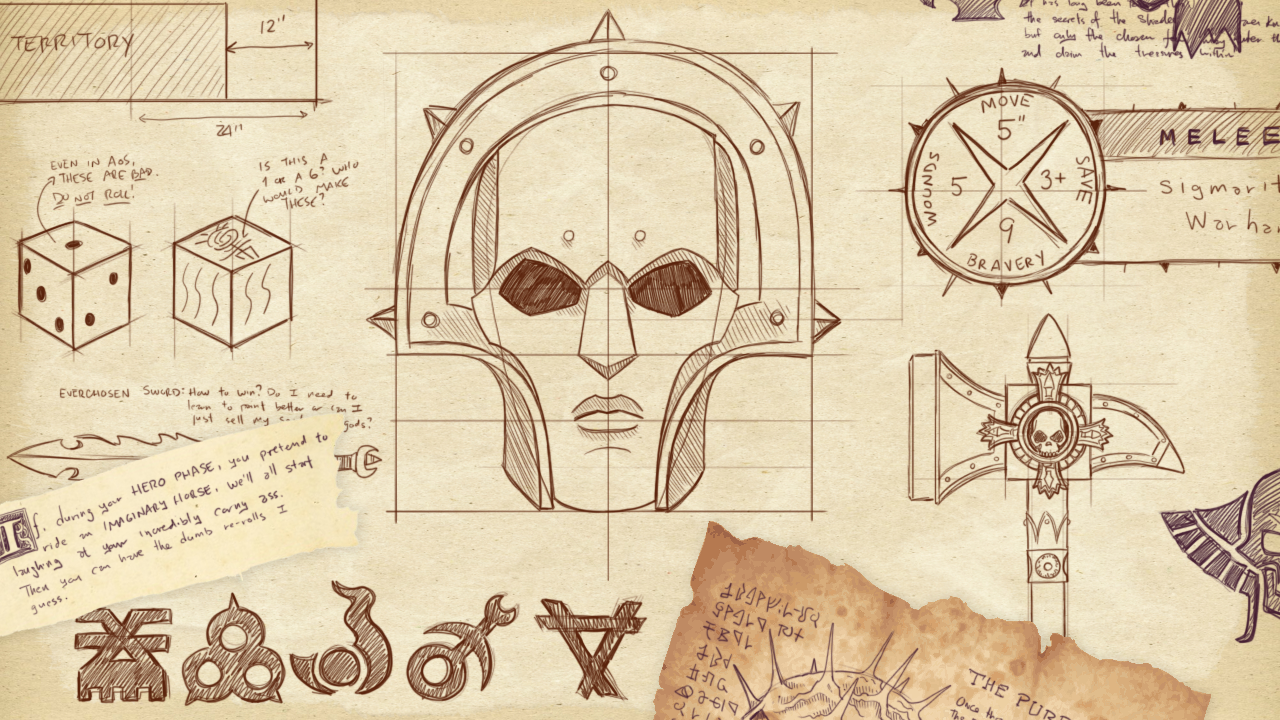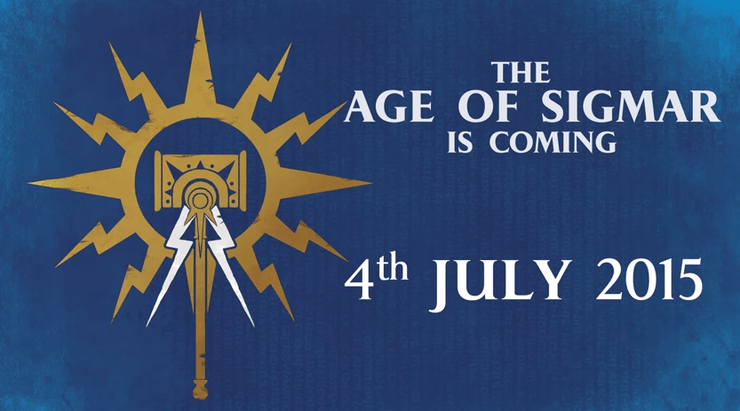Age of Sigmar is 5 years old! Light some candles, grab a slice of cake and let’s look back at what it was, what it has become and where it is going.
Release
Warhammer: Age of Sigmar was released in 2015 as the replacement for Warhammer Fantasy Battle. To say that the launch did not go smoothly is an understatement; there was already some serious concern and fans were upset about the ending of Warhammer Fantasy’s “Old World,” which had decades of story and development and was a beloved setting for many.
And then Games Workshop started unveiling the rules for the new game:
…There were only 4 pages of rules.
…Gone were the massed ranks of infantry and the rank and flank gameplay that people loved.
…Square bases were gone. You would have to re-base your entire army on round bases.
…There were no points in the game. Players were expected to pick what they thought was a balanced army.
…There were some utterly crazy “flavour” rules – a famous example is the rule for Kurt Helborg:
“Helborg’s skill is as legendary as his moustache is magnificent. You can re-roll any failed hit rolls when attacking with the Runefang so long as you have a bigger and more impressive moustache than your opponent.”
This was far from the only rule of its type, and the others were worse – the crowd who had been paying Warhammer Fantasy Battle didn’t exactly consist of people desperate to pretend to ride an imaginary horse for in-game benefits. Never mind the mass re-labelling of Orcs to Orruks, Ogres to Ogors, Elves to, uh, Aelves, and so on.
All of this was teased slowly before the game was released and the internet did what it is famous for – reacted calmly and with composure. Nah, people started filming themselves burning their armies, gaming review sites roundly mocked the new rules and there was a mass exodus of players before the rulebook was even on the shelves.
I cannot really put this in a kind way: The release was an utter disaster.
Silks: I was one of the people that widely mocked Age of Sigmar on release. I was heavily invested in Warhammer Fantasy, it having been the game I got back into when I rediscovered the hobby, and having read a lot of books and played in roleplaying campaigns. At this point me and all of my Warhammer Fantasy friends defected to playing Warmachine.
SRM: You didn’t technically have to rebase your army at launch, as distances were model-to-model, meaning you had models standing on each others’ bases. Changing distances to base-to-base was a pretty common houserule. I wasn’t outright mocking AoS at launch, but between it and the then-current 7th edition 40k, it wasn’t exactly a great time to be playing GW games.
RagnarokAngel: If you somehow came into Age of Sigmar and missed out on this launch, note that nobody is exaggerating how badly bungled it was. Even if they didn’t wipe out a beloved fantasy wargame to make way for this there was just zero care put into it and to this day I can’t quite understand what a lot of the thought process must have been in order to get there. The excellent interview with James Hewitt by our own Corrode and Lupe sheds some light on what happened here. The genuinely clever Keeper of Secrets special rule (which originally let you offer an enemy Hero a boost to attacks in return for dying on a 6, Slaanesh’s sacred number) morphed into needing to create dozens of special rules with, uh, questionable quality.
The fans step in
Those gamers who stuck with it, or those that were attracted by the idea of smaller buy ins (a Warhammer Fantasy army was crazy expensive and could easily involve several hundred models, many of which were effectively trash, taken just to bulk out a big Steadfast unit of Goblins or Skaven) were actually quite impressed. The 4 pages of rules meant you could play the game without constantly having to look up tables and obscure rules and focus on having fun. The new Stormcast Eternal models were actually a lot better than they were initially given credit for and the silly moustache rules were ignored and disappeared from actual play pretty quickly.
But still, the lack of points was a major sticking point as however “light” the system is intended to be, some gamers will always want to play in a competitive setting and relying on your opponent to decide what a balanced army was just wasn’t going to work. So a set of dedicated fans set about creating “comp” rules sets to give models points values for their events. Comp had always been a part of Warhammer Fantasy (either banning or increasing / decreasing points of certain problem units). The most famous of these was “Mo Comp” which was adopted pretty widely and suddenly there was a thriving scene of excited gamers exploring a new game together and having fun. As well as this there was Warscroll Builder, a fan made site where you could build your armies online, which proved very popular. A large core of these fans are still involved heavily in the game and the feeling that the community helped to create Age of Sigmar is what makes the competitive scene such a friendly place.
Silks: This period of Age of Sigmar was kind of a mystery to me until afterwards. I was happy playing Warmachine and the competitive AoS scene was almost underground, especially since GW still hadn’t quite embraced Social Media and supporting their games like they do now.
SRM: I remember walking by the very first Age of Sigmar tournament at NOVA Open, and there were maybe half a dozen people involved. I don’t know if I thought it was a sunk cost fallacy on their part or they were seeing something I just didn’t. I was only tangentially aware of any of the community around it, since they were so often drowned out by the gnashing and wailing of ex-Fantasy players, sneering players of other games, and folks who barely game at all who just like laughing from the sidelines. In hindsight, the diehards who stuck with it really are responsible for AoS being the game it is today, and I’m glad they bought in so hard from the start.
RagnarokAngel: God bless those crazy bastards.
The General’s Handbook
Games Workshop saw what was happening with Mo Comp and Warscroll builder and decided they needed to bring this in house. Several key people were either hired or brought on as playtesters and consultants and all of that was fed into the General’s Handbook. First released in 2016, this was the book that really brought Age of Sigmar kicking and screaming into being a “respectable” wargame.
This introduced the 3 ways to play (which was adopted by Warhammer 40k), added well received tournament missions and, crucially, added points to every unit in the game. Warscroll Builder was also acquired by Games Workshop and added to the Warhammer Community site.
Those of you that play 40k will probably think this seems familiar, and indeed it was adopted for Chapter Approved in 8th edition 40k.
This coincided with Games Workshop emerging from their self imposed exile from the competitive gaming world, and more Battletomes being released for factions, and the game really took off in popularity.
The lore was solidified a lot more, as well. While people were overly critical about how little the lore had going on, it wasn’t an incorrect statement to be making. They did just wipe out one of the longest lasting, most beloved fantasy settings to replace it with something that was a lot harder to build an attachment to. The world was light on detail, with armies fighting over indistinct magical planes with very little happening to ground all the fighting in a real setting. During this period GW made big efforts to try to change that; Malign Portents is considered the beginning of Age of Sigmar shifting toward a more solid setting with some of the darker flavour of the Old World, and it’s still held up as one of the best campaigns for the setting.
The General’s Handbook had two releases before along came the 2nd edition of the game in 2018…
Silks: It was during the first General’s Handbook release when I first got persuaded to give Age of Sigmar a go. I had a Sylvaneth army and had one of the most fun tournaments I’ve ever been to. I then got a Stormcast Eternals army which I played until the second edition. I loved the fact that the game was super simple to learn, with none of the keywords which blighted 7th edition 40k, yet complex enough that you could put a lot of time into getting good.
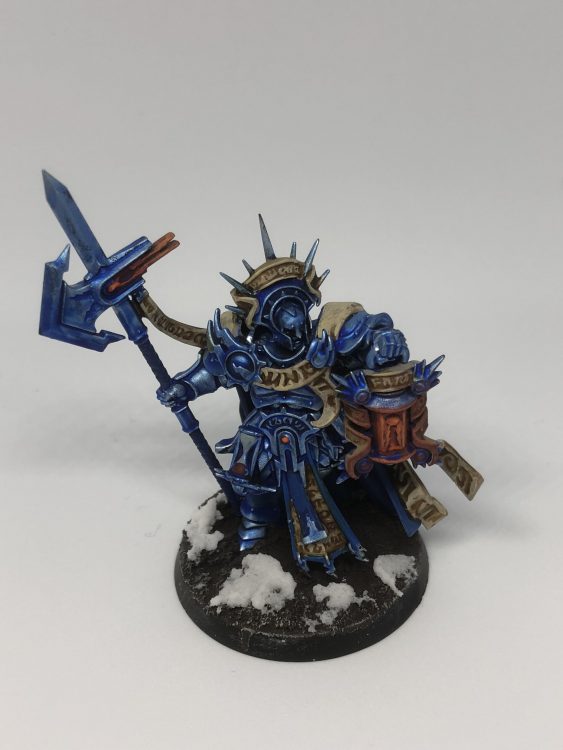
SRM: Similarly, this is when I got into the game. I had buddies who had been trying to get me to play for a while – they were all new dads who were happy they could play a lightweight wargame where the rules are made up and the points don’t matter. Even as a pretty casual player, the thought of a game without points put me off – I’d played enough bad games where the two players just eyeballed army balance when I was a teenager. Once the first General’s Handbook came out though, I got interested. I’d already been painting a Warhammer Fantasy Empire army since Total War: Warhammer caught my eye, and nobody (myself included) really wanted to play 9th Age, so I gave Age of Sigmar a spin. I joined up with my buddies (who were all playing with their old Skaven, Dwarf, and Wood Elf armies) and started playing Oldhammer-flavored Age of Sigmar on the regular. I found a game that was faster playing and more fun than 7th edition 40k, which was crumbling under its own rules weight. There was still enough flavor to “feel” right, and the points were balanced enough that games felt close and exciting. For the next year or so, Age of Sigmar became my primary game.
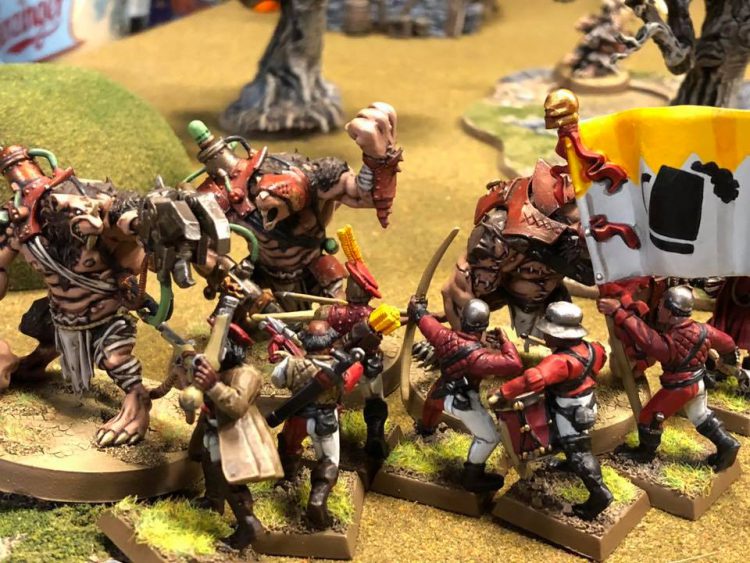
RagnarokAngel: I also got in around the point 2.0 came out. I remember seeing a post on my FLGS asking if someone wanted to play Age of Sigmar. I had Tzeentch Daemons from playing 40k and figured it was a practical place to play without buying new models. So I grabbed the Tzeentch Battletome, and made a list by just slamming together what I had in a haphazard list…
…and I had a lot of fun! The rule set was pretty familiar to 8th ed 40k (which is natural given how 8th ed was inspired by it) and so I was able to take to it like a duck to water. I felt like the ruleset was a lot more relaxed and had some really interesting off the wall ideas like Tzeentch’s destiny dice. Games Workshop during this period seemed to feel like they had little left to loose with Age of Sigmar so why not just get weird with it? It’s honestly the part of the game I really enjoyed the most and I’m glad it’s kept its sort of off the wall nature.
Age of Sigmar 2.0
Games Workshop shocked fans by announcing that just 3 years after the launch of Age of Sigmar they would be releasing a second edition. Gone was the idea of only 4 pages of rules and instead a traditional hardback book crammed with information was included. While the fundamentals of the game didn’t change, the rules had a lot more depth meaning that arguments over how to interpret a few words were clarified.
Included in the launch of Age of Sigmar was Malign Sorcery, a box of Endless Spells (spells with models that stay on the battlefield until dispelled) and rules for playing in all of the realms of Age of Sigmar, something which had a lot of fluff written about it but until now hadn’t really had an impact on the game.
The release was heralded by a new, darker logo and came with a new faction, the Nighthaunt, as well as a massive collection of new Stormcast Eternals and a new General’s Handbook giving Allegiance abilities to the majority of armies that hadn’t had a release in a while.
This release was much better received than the first!
Silks: I preordered everything for the second edition release and played a lot during this period, switching to Idoneth Deepkin as my main army. The game felt a lot more in-depth and the new Malign Portents and Endless Spells gave a real tactical depth to the game. I went to a fair few tournaments at Warhammer World and they were just as well attended as the 40k ones I went to. Independent tournaments in the UK were also thriving and supported with a Games Workshop presence at the events, which helped give the tournament scene a real sense of support and legitimacy.

SRM: The change with 2.0 wasn’t so much a change for me as it was for my group. This is when I started actually seeing some more representative armies in the game aside from just my Oldhammer crew, and came to face Stormcast, Ironjawz, and Beastclaw Raiders for the first time. This also tested my group’s interest in the game. Necromunda was now competing for attention and at this point 40k was good again. The newly added layers of complexity gave AoS players more to think about, and while my experience with Endless Spells is still pretty insignificant, the expanded rules and Allegiance Abilities really made army building feel like it mattered. It became pretty clear that Age of Sigmar was here to stay, even if people were tired of getting shot to pieces by my accidentally meta-busting Empire gunlines.
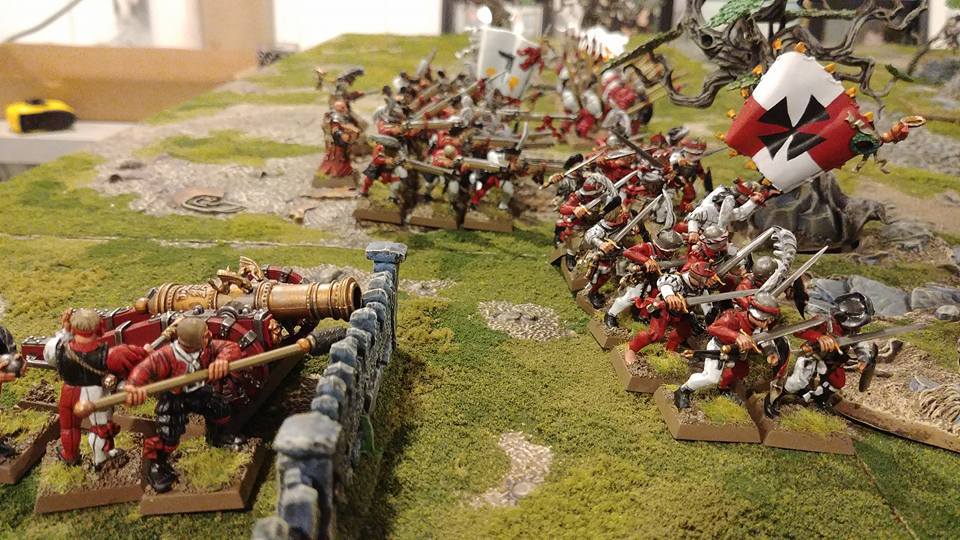
RagnarokAngel: 2.0 represented a turning point for me in that it was when I was finally able to get my friends on board as well. Before I was a bit of a weird outlier, dedicating time to this joke of a game nobody liked. Over time, my enthusiasm wore off on them and a new release with a stronger ruleset was the last push many of them needed to give the game a fair try. Everyone willing to try was pleasantly surprised to find I was not completely crazy and that there was a solid game here. I think that there was always a solid game at its core, the fact that Warhammer 40k 8th edition used it as a foundation for its gameplay was an indicator that there was something to the whole thing, it just had to be dragged kicking and screaming into the sunlight. 2.0 really nailed it in a lot of ways and I think the Soul Wars set was able to bring a lot of new people in, especially off of the tailwinds of 8th edition 40k giving Warhammer as a whole a real shot in the arm.
The Current Game
With the General’s Handbook 2020 imminent the game is probably the healthiest it has ever been. Whilst there have been some “problem” factions (I’m looking at you Slaanesh and Tzeentch) they have eventually been dealt with either by FAQs or General’s Handbook releases. Most armies have an up to date battletome and several entirely new factions have been added which have proved very popular.
The community feeling that was created back in the earliest days of the game remains, with many community driven sites analysing stats and the competitive meta. The models are utterly fantastic and often feature in the portfolios of competitive painters and large tournaments are an important part of the calendar for many.
It is unfortunate that COVID-19 has put an end to competitive play and for many, casual play as well. Just as the game seemed to be hitting its stride, real life has to crash down and ruin everything.
Silks: I must admit that recent “overpowered” battletomes have killed the game for me a bit. However, the game itself is still brilliant fun and these problem children have been stomped on pretty hard eventually.

SRM: I’ll admit, I’m somewhat insulated against the more unbalanced aspects of the game, as my regular opponents are pretty good about self policing that sort of thing. Instead, I’ve just seen more interesting armies rising up amongst my group and looked out at the greater community from afar. This has meant experimenting with our existing armies more, trying different builds, and really highlighting the flexible nature of the game. If anything, the game has largely been secondary to the painting and modeling aspects of the hobby, and more than anything I’ve loved seeing how the community runs wild with their ideas with such an inventive model range.
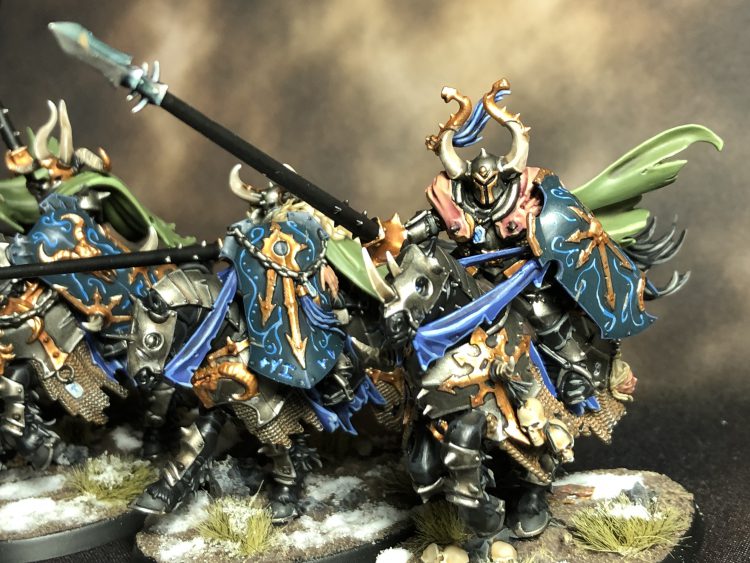
RagnarokAngel: Thanks to COVID I haven’t gotten to play any games in months which is a real downer. Following the meta pre-COVID has been a real trip though. People thought Ossiarch Bonereapers were going to be an impossible to stop juggernaut, only for Tzeentch to dash those against the walls before it ever had a chance. Thankfully they fixed Tzeentch pretty quickly but its hard to say by how much since COVID put a stop to all tournaments so soon after. I don’t think there’s been “a string of overpowered Battletomes” as much as a couple of irregularities. God I miss actually playing games.
The Future
We have just had a limited release of a new faction – the Lumineth Realm Lords – and we know their full release is in September. As well as that we know that the equivalent of Knights from 40k, the Sons of Behemat (an army of Giants, or Gargants in AoS parlance) is imminent. There is a lot more scope for adding new factions than there was in Warhammer Fantasy (and indeed than there is in 40k) and this seems to be something that the design team are embracing.
And I’m sure that somewhere, deep in the bowels of GW’s head office in Lenton they’re working on Age of Sigmar 3.0
Silks I am currently building and painting my Lumineth Realm Lords and cannot wait to start attending some events. I’m also looking forward to the Super Series on the tSports network which looks to be a really great way to build up the competitive scene to the next level. When tournaments finally resume again I’m probably most excited to get tickets for Age of Sigmar events.
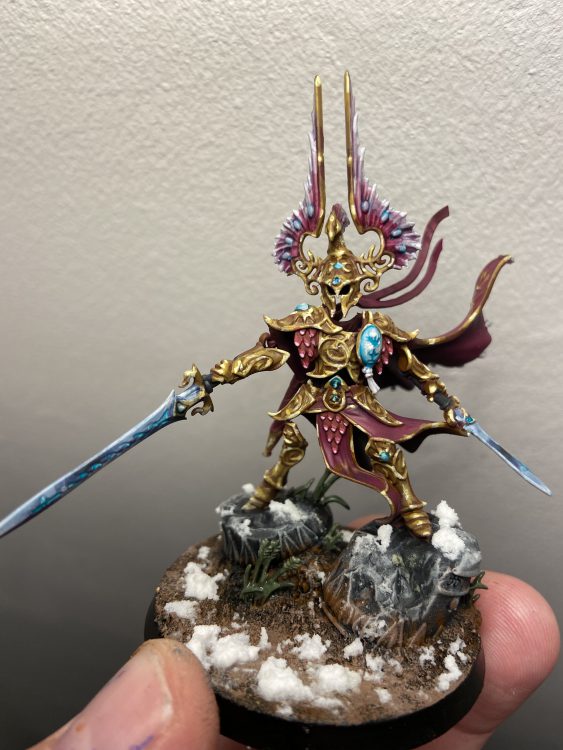
SRM: I’m going hard on my Slaves Daves to Darkness, currently sitting around 1700 points of the spikey lads and lasses. I don’t see myself going to too many events (the current state of Hellworld 2020 notwithstanding) as most of the folks I hang out with at cons are 40k players, but I’m extremely excited to get back to playing and maybe even get some campaign action going. Folks in my group are already working on Gargants for Sons of Behamat and building up undead and Kharadron Overlords armies, so I’m excited to face an even more diverse set of armies and really see Age of Sigmar in its own light, out of the shadow of Warhammer Fantasy.
RagnarokAngel: When Lumineth were announced I knew I’d be going all in, as I’d been waiting for a substitute for High Elves after most of the models got axed with the release of Cities of Sigmar. Shame COVID had to limit the release. Shame what COVID has done to a lot of things for the hobby really. Age of Sigmar’s growth has been a big deal for me. It went from this game I only ever heard talked about as a walking punchline to my favorite wargame out there. Hell, it’s because the game has left such a positive impression on me that I managed to get involved with Goonhammer (suckers). I’m really excited for where the game is going because aside from some minor missteps I feel like the game devs have really been nailing it in terms of creating interesting mechanics that are well-balanced. As SRM stated above, the game has done a phenomenal job of bringing itself out of Warhammer Fantasy’s shadow and with The Old World coming (eventually) as its own entity, that seems all the more evidence that Age of Sigmar is here to stay.
Thank you for joining us on this nostalgia trip. Let us know about your Age of Sigmar journey either through contact@goonhammer.com or on social media!
